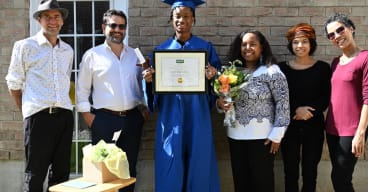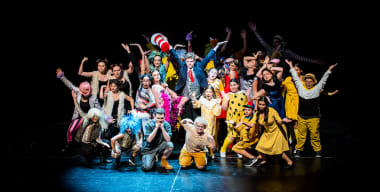Great insights are accessible and a short step off the beaten path of exercise and drill that remain foundational in even the most progressive math program. As certainly as our culture demands scientists and mathematicians to be skilled technicians, the realities of life on the planet require our planners and builders to be of fearless imagination and bold creativity. As certainly as technical proficiency is to remain the hallmark of success in mathematics, the instinct to invent, to seek patterns and to wonder aloud come to the fore as we know our collective fate on Earth is tied to our planners, lawmakers and our engineers having wide visions and novel ways to solve old problems.
So let imaginative mathematical experience begin as soon as possible for students that they might swiftly and eagerly move past the numbers 1, 2, 3 to the something/nothing/everything numbers One, Zero, Infinity. Like the richest themes of good studies in English literature and art history, our somethings, nothings and everythings can be made to creep in and out of conversation, and enliven topics in all directions of a continuous math course.
One (1)
The somethings we count and manipulate as arithmetic. We encounter the number 1 as early as our first memories. It is the simplest of all number concepts, the repeated building up, regrouping and subdividing of bunches of them upon which the rest of arithmetic is built.
Zero(0)
The absence of all countable things–marks our void, a vacuum, the blank slate of a Zen master.
Infinity (?)
The state of accumulating all the somethings into everything–occurs to us as what we get when we never stop counting. ?, the cosmos, all, is the antipode of zero.
Staggeringly beautiful realizations arise as we peel back layers of meaning from things weve trusted about our numbers and about our minds and our world. We find ourselves on shifting ground and see weve been there the whole time. Were in the deep water and pleased to be there. Disquieting. Frustrating. Enticing.
Three numbers, three points of departure, now three meaningful inroads to musings and invention. The sensations and accomplishments inherent in puzzling over these themes are as rewarding to a middle-school child as to a graduate physicist. And I hope for you, too.
Math musing: Which is a number?
Is Zero a number and, if so, why then do we need a number for a condition in which we have no number? We have no word for a thought that is empty, nor a letter to signify no sound, so why then a numeric symbol for no thing? Zero occupies a place on the number line, but that place makes so many of our predictable operations turn on their heads that it seems to be a strange place indeed. Use Zero in any operation and see how the rules change: "I have a magic number in mind, such that adding or subtracting it from your favourite number gives your favourite number." "Multiply by my magic number, and you get nothing." "Divide by my magic number, and you get everything." Any number to the power of Zero is a lovely conundrum and the result"one"easy to memorize, but so rich a theme to explore in the why. Zero required inventing, as a feature of our positional number system, and as a philosophical entity; the idea is a great avenue for research and imagination.
What about the value of the number One? Does 1 = 1 sometimes, always or never? If you have one thing, and I have one thing, do we have the same? Is losing nine of your 10 pennies the same as finding one (1=1)? At one time, the first dollar earned–the bill posted on the bakery or barbershop wall–meant everything (1 = ?). Yet dollars spent easily for drinks and cheap toys become virtually meaningless (1 = 0).
Consider Infinity, that place we point to with the arrow on the tail of a number line. But are there other infinities? At the back end of the number line, is there a second ?, a -??
Unlike ?, each number represents a certain value. But how many bit parts fall between numbers? If ? is between 1 and 2, and ? is between 2 and 3, how many infinities then between 1 and 3? And so then does ? = ?? Is it a number, a concept, a process, or does it exist only in the imagination?
Math musing: Countless or Infinite
Pondering the infinite can begin with vocabulary, as we commonly intermingle our uses of the words "countless" and "infinite." No matter the vastness, even numbering billions of billions, stars in the sky are countless: difficult to count, but still countable; finite, not infinite. The distinction between the countless and the infinite becomes our point of departure here–be it stars in the sky, grains of sand, angels on the head of a pin, molecules in a mountain.
Which are which? Perhaps only one category has any real objects in it. The presence or absence of limits is the key.
Math musing: (In)finite(in)finite
On a number line, how much territory does any single number command? As we mark vertical stripes and number them off, how wide should the mark be to signify your favourite number, let's say 23? And what then for 23.0000000001? (Unless it's the same as 23! An elegant proof that 0.99999...= 1 is well documented on the Internet.) If a baseball can only be in one place at any one instant in time, where is the instant that it slides between places? How many two-dimensional circles need to be stacked to build a 3D cylinder? Step between whole numbers, between instants in time, between places in space, and contemplate the notion and possibility of the infinite between the finite between the infinite.
Math musing: Cantor's Dust
This memorable exercise for turning one into nothing and everything at the same time, like the best of these wanderings, begins with a concrete material situation and instructions for a process that seem too simple to bear deep thought. It is in the simplicity that we maintain that approachable, thin edge of a great wedge, such that every student–and teacher–can walk him or herself into a rewarding and fascinating place.
Each of us begins with one arm's length or thereabouts piece of string–butcher cord is best. Make a simple table to keep track of two things: how many and how much. So, to start:
- How many pieces do we have? 1 piece
- How much string do we have? 1 length
Cut the length into thirds. Remove and throw away the middle third, and count:
- How many pieces do we have? 2 pieces
- How much string do we have? Less than 1 length
Cut each of the remaining two pieces into thirds, again remove the two middle thirds, and count:
- How many pieces do we have? 4 pieces
- How much string do we have? Less than before
As we repeat the cutting, removing and counting:
- How many pieces? More
- How much string? Less
Until the real world breaks down, and only mathematics can continue: the bits of string become too tiny to cut. But our pattern in that simple table is mathematical: even with ridiculously few numbers to show, the trend clearly set in motion with real bits of real stuff is free to continue apace... The instinct of a mathematician–establish a pattern in whatever realm is real, and then extend it into the unknown–is like a safety line into a dark cave. Trust the pattern so simply begun to continue to hold where observable reality cannot go.
How Many - How Much
- 1 - 1
- 2 - less
- 4 - even less
- more - and even less
- ... - ...
- ? - 0
Our chart implies continuing our process forever, obviously beyond the limits of the physical world. So let ? sit in for the ultimate more in How Many, and 0 for the ultimate imaginary less in How Much. The remaining string dust bears the name of Georg Ferdinand Ludwig Philipp Cantor, a mathematician who spent his career pondering the infinite and who, legend says, died alone and mad as a related result. Sweep together the remaining string bits at the end of that infinite process and what do the infinite number of parts with zero total volume add up to? Nothing or everything? Yes.









